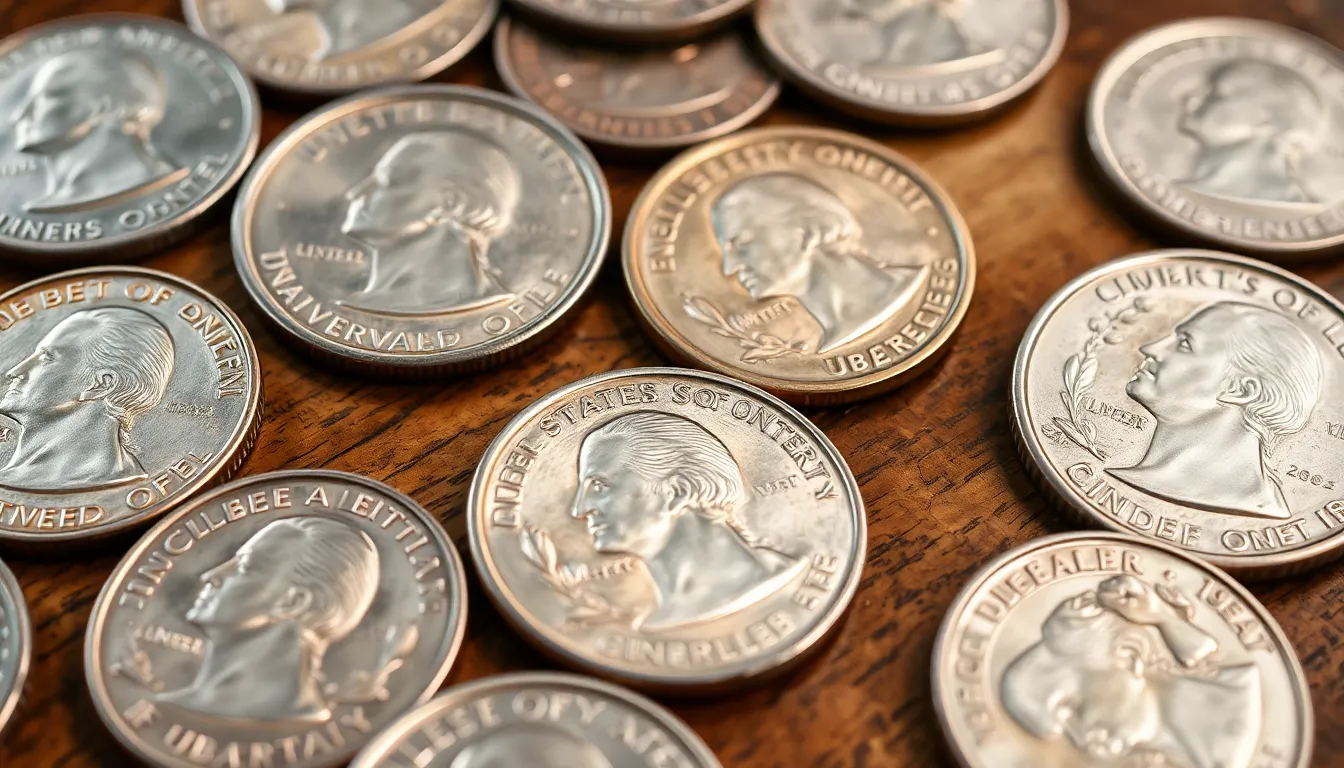In a world where pocket change often gets tossed aside, some modern quarters are sneaking in a surprising twist: they’re worth more than their face value. Who would’ve thought that a little nickel and copper could pack such a punch? Quarters minted after 1964 may seem like mere coins, but hidden among them are rare finds that could make collectors drool and bank accounts swell.
Table of Contents
ToggleUnderstanding Modern Quarters
Modern quarters, especially those minted after 1964, often hide value beyond their face value. Specific instances like the 1999-S Silver Proof Quarter can fetch around $10 to $15, depending on condition. Not all quarters are created equal; some from the America the Beautiful series can carry premiums.
In 2004, the State Quarters Program introduced coins with unique designs representing each state. Certain state quarters, particularly those with low mintage, are more sought after. For instance, the 2004 Wisconsin quarter, with a correct leaf error, can reach $100 or more in great condition.
Another valuable group includes quarters with errors. Types of errors like double dies, missing elements, or off-center strikes enhance their collectibility. The 2000-P Maine quarter, for example, can reach a value of $10 to $12 due to a notable error.
High-quality specimens significantly affect pricing. Full Mint State grades on coins influence collector interest. Many collectors seek quarters in uncirculated conditions, further increasing value. Furthermore, pairing uncommon dates or mint marks boosts a quarter’s desirability.
Although not every modern quarter is worth money, specific exceptions merit attention. Collectors should stay informed about market trends and follow auction results for the latest values. With due diligence, recognizing these valuable coins can lead to rewarding discoveries in everyday pocket change.
Key Characteristics of Valuable Quarters

Valuable quarters possess specific traits that significantly impact their worth. Understanding these characteristics can guide collectors to make informed purchases.
Mint Marks and Their Importance
Mint marks reveal where a quarter was struck. Common mint marks include “P” for Philadelphia, “D” for Denver, and “S” for San Francisco. Some quarters, especially those from the San Francisco mint, attract collectors due to lower production numbers. Coins without mint marks, such as those from the Philadelphia mint, also hold value, but the rarity of mint-marked coins contributes to higher price tags. For example, quarters from the America the Beautiful series often feature unique mint marks that collectors seek. Knowing the mint mark can elevate a quarter’s status in the market.
Condition and Grading Scale
Condition impacts how much a quarter is worth. Collectors use a grading scale, typically ranging from Poor to Mint State. Coins in Mint State condition can fetch prices many times above their face value due to their pristine appearance. Grading involves assessing factors such as scratches, dents, and overall wear. Uncirculated coins, which show no signs of circulation, are particularly desirable among buyers. For instance, a quarter in near-perfect condition attracts greater interest than a heavily worn equivalent. Establishing the correct grade helps determine a quarter’s market value accurately.
Notable Modern Quarters to Watch
Certain modern quarters hold significant value beyond their face value. Collectors focus on specific types, particularly state and national park quarters.
State Quarters
State quarters, released in 1999 through 2008, are widely sought after due to their unique designs. The 2004 Wisconsin quarter stands out, featuring a rare “correct leaf” error, valued at $100 or more. Other quarters from this program, like the 2005 California quarter with the “mine” error, can also attract interest, selling for $25 or higher. Mint marks add another layer of value, with quarters from the San Francisco mint often more desirable. Collectors should inspect their collections closely, as variations in design can significantly impact worth.
National Park Quarters
National Park quarters debuted in 2010, showcasing stunning park designs. Particular coins, such as the 2010 Yellowstone quarter, may fetch around $10 due to their minting errors or unique features. The 2019 American Memorial Park quarter is another example, with certain discrepancies boosting its value to $12 or more. Condition plays a crucial role, as uncirculated quarters yield higher premiums. Collectors remain keenly aware of these attributes, ensuring they don’t overlook valuable pieces in circulation.
Factors That Affect Value
Understanding the elements influencing a quarter’s value helps collectors maximize their investments. Two primary factors are rarity and demand, followed closely by market trends.
Rarity and Demand
Rarity plays a crucial role in determining a quarter’s value. Limited mintage or specific errors often increase desirability among collectors. For instance, the 2004 Wisconsin quarter, known for its “correct leaf” error, attracts significant interest. Demand varies based on collector preferences, with popular designs and state representations commanding higher prices. A quarter that’s hard to find often leads to competitive bidding at auctions, significantly boosting its market value. Unique features, like unusual mint marks or striking errors, enhance rarity further, making select quarters highly sought after.
Market Trends
Market trends significantly impact the valuation of modern quarters. Changes in collector interest can arise from coin shows, auctions, or online sales platforms. Recent years have shown a growing fascination with both state and national park quarters, affecting their market prices. Increased awareness about specific mintage years also informs buyers about potential investments. Tracking auction results provides insights into buyer behavior and prevailing prices. It’s essential for collectors to stay updated on current market conditions to navigate sales effectively, ensuring informed decisions.
Where to Buy and Sell Valuable Quarters
Collectors commonly utilize various platforms to buy and sell valuable quarters. Online marketplaces like eBay provide access to a wide audience, allowing sellers to list coins with detailed descriptions and images. Local coin shops present another option, offering in-person evaluations and transactions.
Auction houses facilitate competitive bidding for rare quarters, often achieving higher prices than regular sales. Coin shows hold potential for both buying and selling, where enthusiasts gather to trade and share information. These events highlight rare finds, such as the 2004 Wisconsin quarter featuring the “correct leaf” error, which can draw attention from serious collectors.
Buying directly from individual collectors through forums or social media groups presents a unique opportunity for deals. Networking within these communities can lead to exclusive offers or trade options that aren’t typically available elsewhere.
Valuable quarters often appear in estate sales, so visiting these can lead to unexpected discoveries. Researching local estate sales and attending them regularly can yield lucrative finds with minimal competition.
When selling quarters, accurate grading and clear presentation ensure better outcomes. Providing detailed descriptions and high-resolution images leads to informed buyers willing to pay a premium. Furthermore, seeking current market trends remains crucial; staying updated on auction results and market fluctuations helps in pricing coins effectively.
Investing time in learning about specific quarters increases confidence and sharpens negotiation skills, which can enhance buying and selling experiences. Engaging with the coin-collecting community fosters valuable connections, ultimately benefiting both novice and seasoned collectors.
Modern quarters hold more value than many realize. With certain coins from the State Quarters Program and the America the Beautiful series fetching impressive prices, collectors have ample opportunities to enhance their collections and investments. The rarity and condition of these coins play a significant role in their market value.
By staying informed about trends and actively engaging with the coin-collecting community, individuals can uncover hidden treasures in their pocket change. Whether it’s a rare mint mark or an error coin, the potential for profit makes exploring modern quarters an exciting venture for both new and seasoned collectors.


